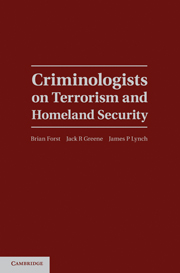Book contents
- Frontmatter
- Contents
- About the Authors
- Preface
- 1 Introduction and Overview
- PART I NATURE OF THE PROBLEM
- 2 Manifestations of Aggression
- 3 The Etiology of Terrorism
- 4 Balancing Counterterrorism Strategies
- 5 Gangs, Crime, and Terrorism
- 6 Women Terrorists
- PART II STRATEGIES FOR INTERVENTION
- PART III THINKING ABOUT TOMORROW
- Index
- References
3 - The Etiology of Terrorism
Identifying, Defining, and Studying Terrorists
Published online by Cambridge University Press: 04 February 2011
- Frontmatter
- Contents
- About the Authors
- Preface
- 1 Introduction and Overview
- PART I NATURE OF THE PROBLEM
- 2 Manifestations of Aggression
- 3 The Etiology of Terrorism
- 4 Balancing Counterterrorism Strategies
- 5 Gangs, Crime, and Terrorism
- 6 Women Terrorists
- PART II STRATEGIES FOR INTERVENTION
- PART III THINKING ABOUT TOMORROW
- Index
- References
Summary
Identification is the first step in assessing, predicting, and ultimately intervening effectively in terrorist actions. To date, there has been limited success in identifying who terrorists are and where they can be found, tracking their activities, and then preventing them from engaging in attacks in the future. Despite successes by law-enforcement authorities at intercepting terrorists, whether reported to the public or not, a single unrestrained terrorist group or individual who succeeds in an attack can render devastating consequences. Just as Timothy McVeigh in Oklahoma City and al Qaeda in New York demonstrated, even overlooking one terrorist or terrorist cell can have significant, deadly societal and political ramifications.
But how were terrorists in the Oklahoma bombing and 9/11 allowed to slip through the cracks? Sophisticated intelligence-gathering capabilities, state-of-the-art investigative procedures, and other threat-analysis techniques seemingly failed in these instances. What specifically went wrong? Or did anything go wrong that was preventable? Why were we not able to identify these terrorists? Had they been identified, could we have stopped them from committing acts of mass murder against a helpless civilian population? This chapter will address the fundamental issues of defining terrorism and terrorists, and examine our ability to understand these phenomena. It will further examine the challenge of collecting data concerning the threat terrorism poses to public safety.
DEFINING TERRORISM
One of the most significant difficulties in the identification of terrorism and terrorist individuals or groups is that of multiple definitions of basic terms.
- Type
- Chapter
- Information
- Criminologists on Terrorism and Homeland Security , pp. 40 - 65Publisher: Cambridge University PressPrint publication year: 2011



